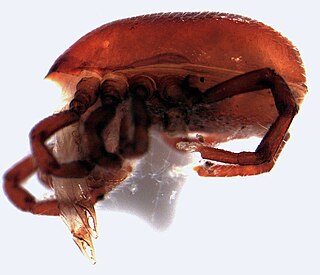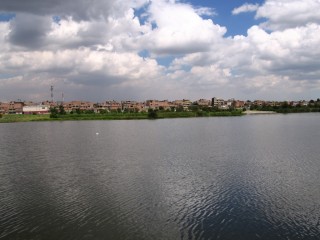
A spirochaete or spirochete is a member of the phylum Spirochaetota, which contains distinctive diderm (double-membrane) gram-negative bacteria, most of which have long, helically coiled cells. Spirochaetes are chemoheterotrophic in nature, with lengths between 3 and 500 μm and diameters around 0.09 to at least 3 μm.

Opilioacaridae is the sole family of mites in the order Opilioacarida, made up of about 13 genera. The mites of this family are rare, large mites, and are widely considered primitive, as they retain six pairs of eyes, and abdominal segmentation. They have been historically been considered separate from other mites belonging to Acariformes and Parasitiformes, but are now generally considered a subgroup of Parasitiformes based on molecular phylogenetics.

Peter A. Hammen is an American politician who represented the 46th legislative district in the Maryland House of Delegates. Delegate Hammen was also the Chairman of the House Health and Government Operations Committee.

I. M. Johnston, was a United States botanist. He studied at Pomona College in Claremont, California and at Harvard University. His plant collections are housed in the Rancho Santa Ana Botanic Garden, in Claremont, and also in the Gray Herbarium of Harvard University.

El Abra is the name given to an extensive archeological site, located in the valley of the same name. El Abra is situated in the east of the municipality Zipaquirá extending to the westernmost part of Tocancipá in the department of Cundinamarca, Colombia. The several hundred metres long series of rock shelters is in the north of the Bogotá savanna on the Altiplano Cundiboyacense, Eastern Ranges of the Colombian Andes at an altitude of 2,570 metres (8,430 ft). The rock shelter and cave system is one of the first evidences of human settlement in the Americas, dated at 12,400 ± 160 years BP. The site was used by the hunter-gatherers of the Late Pleistocene epoch.

The Holothyrida are a small order of mites in the superorder Parasitiformes. No fossils are known. With body lengths of more than 2 mm they are relatively large mites, with a heavily sclerotized body. They mainly feed on the body fluids of dead arthropods. This was possibly the common way of feeding for ticks before they adapted for feeding on the blood of live animals.

The Serranía de Chiribiquete or Chiribiquete Mountains are a group of isolated table mountains in the Amazon Region of Colombia. The mountains are part of the western edge of the Guiana Shield. The area is protected as a national park. This area is habitat for the Chiribiquete emerald, an endemic hummingbird. The waterfall Caño Paujil originates from the Serranía de Chiribiquete.

Ampullaviridae is a family of viruses that infect archaea of the genus Acidianus. Only one genus in this family has been described, Bottigliavirus, which contains three species. The name of the family and genus is derived from the Latin word for bottle, ampulla, due to the virions having the shape of a bottle. The family was first described during an investigation of the microbial flora of hot springs in Italy.

Tibabuyes or Juan Amarillo Wetland is a wetland, part of the Wetlands of Bogotá, located in the localities Suba and Engativá, Bogotá, Colombia. The wetland, in the Juan Amarillo River basin on the Bogotá savanna is the largest of the wetlands of Bogotá and covers an area of 222 hectares.
Ictalurivirus is a genus of viruses in the order Herpesvirales, in the family Alloherpesviridae. Fish serve as natural hosts. There are three species in this genus. Diseases associated with this genus include: channel catfish disease.

The Thomas van der Hammen Natural Reserve or Thomas van der Hammen Forest Reserve is an area of the Bogotá savanna that is under environmental protection. The natural reserve was declared as such in year 2000 by the Ministry of Environment and Sustainable development. It takes its name from the Dutch-Colombian geologist Thomas van der Hammen who devoted his life to the research of the region. The surface area of the protected reserve is approximately 1,395 hectares and it is located in the north of Bogotá.
Synchthonius is a genus of mites.
Brachychthoniidae is a family of oribatids in the order Oribatida. There are about 11 genera and at least 150 described species in Brachychthoniidae.
Achipteriidae is a family of mites and ticks in the order Sarcoptiformes. There are about 9 genera and at least 80 described species in Achipteriidae.

Enarthronota is a suborder of mites in the order Oribatida. There are about 14 families and more than 450 described species in Enarthronota.
Joanne Davila is a clinical psychologist known for her research on the romantic relationships and mental health of adolescents and adults, including the impact of social media use on relationships and well being. She is a Professor and Associate Director of Clinical Training int the Department of Psychology, at Stony Brook University.
Fortuynia is a monotypic genus of flowering plants belonging to the family Brassicaceae. It only contains one species, Fortuynia garcinii(Burm.f.) Shuttlew..

Allothyridae is a family of mites belonging to the order Holothyrida.
Fortuyniidae is a family of mites belonging to the order Sarcoptiformes.

Father Chrysanthus O.F.M. Cap., born Wilhelmus Egbertus Antonius Janssen, was a Dutch priest and biology teacher. He was known for his studies in arachnology. Initially he was concerned with the spiders of the Netherlands but he became a specialist on New Guinea spiders. Two spider species were named in his honor following his death.












